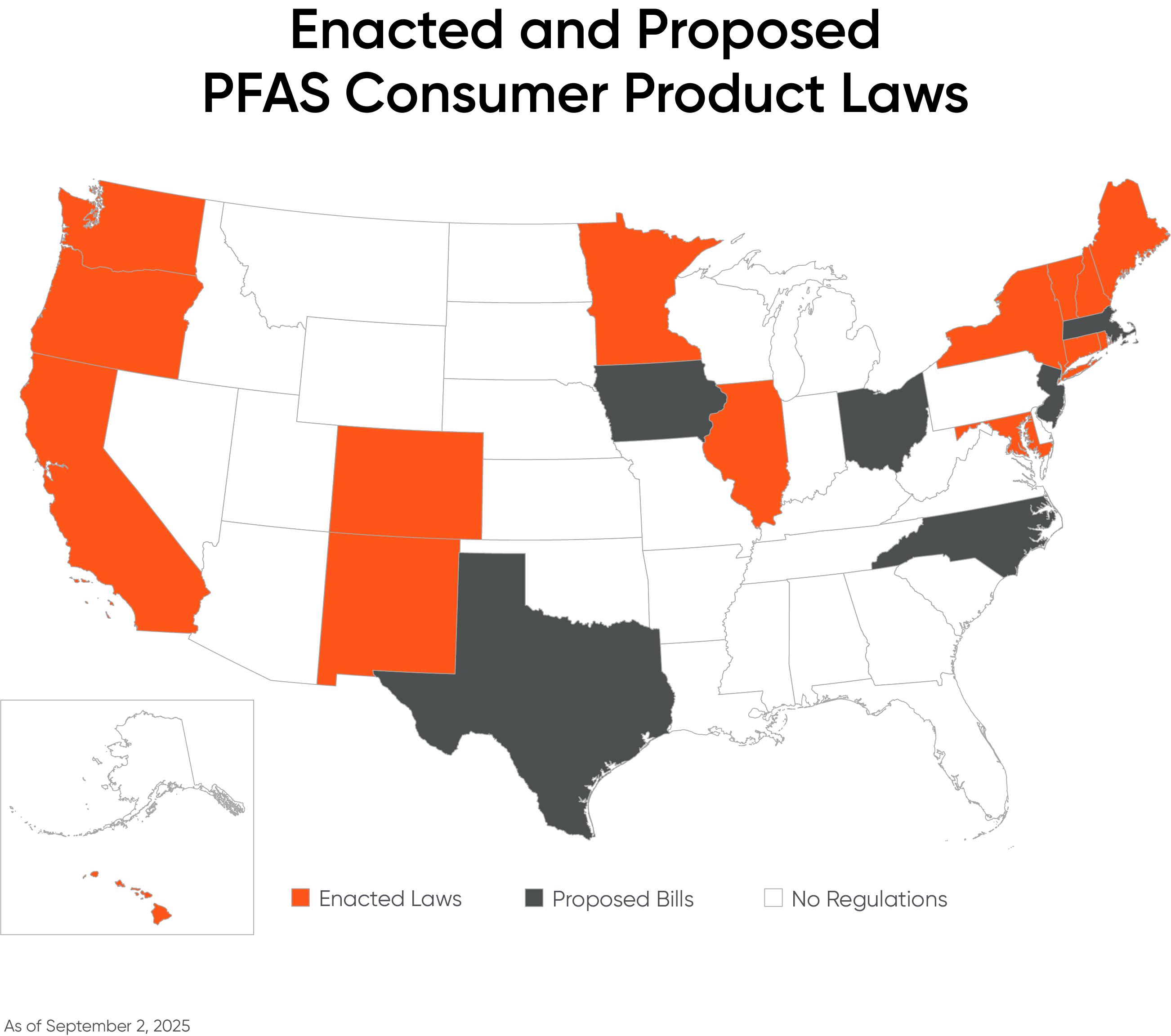Insights
PFAS in Consumer Products: State-by-State Regulations
Updated: September 2025
Sep 02, 2025Summary
Manufacturers, distributors, and retailers of consumer products across a broad spectrum of industries are being impacted by state laws regulating the presence of per- and polyfluoroalkyl substances (“PFAS”) in their products. This area is rapidly developing as states create new laws or amend existing ones, and the penalties and litigation risks for non-compliance can be significant.
PFAS Background
PFAS are a family of chemicals comprised of somewhere between 8,000-15,000 compounds depending on the regulatory definition. According to the EPA, PFAS can be found in food packaging, household products, and personal care products. Not surprisingly, these categories – along with others - have been the focus for states as they develop and implement their consumer product PFAS laws.
Specific Consumer Product Regulations
Below is an overview of enacted and proposed state laws and regulations as of August 29, 2025, to assist you in investigating whether your products may be impacted.

The following information identifies what specific product categories each state regulates, but does not include the specific regulatory requirements to avoid confusion because the structure and, in some cases, limits vary widely from state to state.
Product Categories
Proposition 65: All consumer products sold to California consumers may require warnings if these products contain PFOA, PFOS, PFOS salts and transformation and degradation precursors, and PFNA and its salts above safe harbor levels.
Regulatory Status
Enacted
Reference and Details
Health and Safety Code §25249.5
California’s Office of Environmental Health Hazard Assessment information
Product Categories
Cosmetics
Regulatory Status
Enacted
Reference and Details
AB 2762, AB 496, AB 2771 and AB 496
Product Categories
Rugs and carpets
Regulatory Status
Enacted
Reference and Details
Product Categories
Cookware and food packaging
Regulatory Status
Enacted
Reference and Details
Product Categories
Children’s products
Regulatory Status
Enacted
Reference and Details
Product Categories
Recycling
Regulatory Status
Enacted
Reference and Details
Product Categories
Composting
Regulatory Status
Enacted
Reference and Details
Product Categories
Textiles and apparel
Regulatory Status
Enacted
Reference and Details
Product Categories
Treatments – converted textiles or leather
Regulatory Status
Enacted
Reference and Details
Product Categories
Feminine Hygiene Products
Regulatory Status
Enacted
Reference and Details
Product Categories
Testing and Registration:
- Juvenile Products;
- Textile Articles; and
- Food Packaging
Regulatory Status
Enacted
Reference and Details
Product Categories
- Cleaning products;
- Cookware;
- Dental floss;
- Juvenile products;
- Food packaging;
- Ski wax; and
- Textile articles
Regulatory Status
Proposed
Reference and Details
Product Categories
- Artificial Turf;
- Cleaning products;
- Cookware;
- Dental floss;
- Juvenile products;
- Food packaging;
- Ski wax;
- Upholstered Furniture; and
- Textile articles
Regulatory Status
Proposed
Reference and Details
Product Categories
- Carpets and rugs
- Fabric treatments
- Food packaging
- Children’s products
- Oil and gas products
- Cookware – certain labelling requirements
- Cosmetics
- Indoor and outdoor textile furnishings
- Indoor and outdoor upholstered furniture
Regulatory Status
Enacted
Reference and Details
Product Categories
- Outdoor Apparel
- Cleaning Products
- Cookware
- Dental Floss
- Feminine Products
- Ski Wax
- Textiles
- Food Equipment
Regulatory Status
Enacted
Reference and Details
Product Categories
Food packaging
Regulatory Status
Enacted
Reference and Details
Product Categories
- Apparel
- Carpets or rugs
- Cleaning products
- Cookware
- Cosmetics
- Dental floss
- Fabric treatments
- Children's products
- Feminine products
- Textile furnishings
- Ski wax
- Upholstered furniture
Regulatory Status
Enacted
Reference and Details
Product Categories
Food packaging
Regulatory Status
Enacted
Reference and Details
Department of Health Information
Product Categories
- Food Packaging;
- Food Service Ware;
- Cosmetics; and
- Personal Care Products
Regulatory Status
Proposed
Reference and Details
Product Categories
-
Cosmetics;
-
Dental Floss;
-
Juvenile Products;
-
Feminine Hygiene Products; and
-
Intimate Apparel
Regulatory Status
Enacted
Reference and Details
Product Categories
- Carpets and rugs;
- Cleaning Products;
- Cookware;
- Cosmetics;
- Dental Floss;
- Fabric treatments;
- Juvenile Products;
- Feminine Hygiene Products;
- Intimate Apparel;
- Textile Furnishings;
- Ski Wax;
- Upholstered furniture;
- Food Packaging; and
- Composting
Prohibits intentionally added PFAS in all products by 2033
Regulatory Status
Proposed
Reference and Details
Product Categories
Cosmetics
Regulatory Status
Proposed
Reference and Details
Product Categories
Juvenile Products
Regulatory Status
Proposed
Reference and Details
Product Categories
- Food Packaging;
- Carpets and rugs;
- Cleaning Products;
- Cookware;
- Cosmetics;
- Dental Floss;
- Fabric treatments;
- Juvenile Products;
- Feminine Hygiene Products;
- Textile Furnishings;
- Ski Wax; and
- Upholstered furniture
Prohibits intentionally added PFAS in all products by 2032
Regulatory Status
Proposed
Reference and Details
Product Categories
PFOS as a “Priority Chemical” in children’s products
Regulatory Status
Enacted
Reference and Details
Product Categories
Food packaging
Regulatory Status
Enacted
Reference and Details
Product Categories
Pesticides
Regulatory Status
Enacted
Reference and Details
Product Categories
Carpets, rugs, and fabric treatments
Regulatory Status
Enacted
Reference and Details
Product Categories
Prohibit PFAS in all consumer products by 2032
Note: some requirements began on January 1, 2023
Regulatory Status
Enacted and proposed
Reference and Details
Maine Department of Environmental Protection Information
"Maine significantly amends its PFAS consumer products law" - BCLP Insight
Product Categories
Fertilizer and composting
Regulatory Status
Enacted
Reference and Details
Product Categories
Various Consumer Products
January 1, 2026:
- Cleaning products
- Cookware
- Cosmetics
- Dental floss
- Juvenile products
- Menstruation products
- Textile articles with two exceptions
- Ski wax
- Upholstered furniture
January 1, 2029:
- Artificial turf
- Outdoor apparel
January 1, 2040:
- Cooling, heating, ventilation, air conditioning, or refrigeration equipment; and
- Refrigerants, foams, or aerosol propellants
Regulatory Status
Enacted
Reference and Details
Maine Department of Environmental Protection Information
"Maine significantly amends its PFAS consumer products law" - BCLP Insight
Product Categories
Agricultural and Farm Products
Regulatory Status
Enacted
Reference and Details
Product Categories
Cosmetics
Regulatory Status
Enacted
Reference and Details
Product Categories
- Food packaging
- Rugs and carpets
Regulatory Status
Enacted
Reference and Details
Product Categories
Pesticides - information
Regulatory Status
Enacted
Reference and Details
Product Categories
Playground materials
Regulatory Status
Enacted
Reference and Details
Product Categories
Pesticides – labeling
Regulatory Status
Proposed
Reference and Details
Product Categories
Various Consumer Products Prohibition
Regulatory Status
Proposed
Reference and Details
Product Categories
Food packaging
Regulatory Status
Proposed
Reference and Details
Product Categories
Mosquito Management
Regulatory Status
Proposed
Reference and Details
Product Categories
- Child Passenger Restraints;
- Children’s Products;
- Cookware;
- Fabric Treatments;
- Personal Care Products;
- Rugs and Carpets;
- Textiles or Textile Furnishings; and
- Upholstered Furniture
Establish various dates, such as January 1, 2030, for stopping the inclusion of PFAS in a variety of consumer products
Regulatory Status
Proposed
Reference and Details
Product Categories
Fertilizer and Composting
Regulatory Status
Proposed
Reference and Details
Product Categories
Children’s Products
Regulatory Status
Proposed
Reference and Details
Product Categories
Artificial Turf
Regulatory Status
Proposed
Reference and Details
Product Categories
Packaging Reduction and Recycling
Regulatory Status
Proposed
Reference and Details
Product Categories
Food packaging
Regulatory Status
Enacted
Reference and Details
Product Categories
Prohibit PFAS Substances in Certain Cannabis Packaging
Regulatory Status
Enacted
Reference and Details
Product Categories
Children’s Products Exceptions
Regulatory Status
Proposed
Reference and Details
Product Categories
- Carpets or Rugs;
- Cleaning Products;
- Cookware;
- Cosmetics;
- Dental Floss;
- Fabric Treatments;
- Juvenile Products;
- Feminine Hygiene Products;
- Textile Furnishings;
- Ski Wax; and
- Upholstered Furniture
By January 1, 2032, prohibit intentionally added PFAS in any product
Regulatory Status
Enacted
Reference and Details
Minnesota Pollution Control Agency (MPCA)
Product Categories
Artificial Turf
Regulatory Status
Proposed
Reference and Details
Product Categories
Pesticides
Regulatory Status
Enacted
Reference and Details
Minnesota Department of Agriculture Information
Product Categories
Tax on Consumer Products with PFAS
Regulatory Status
Proposed
Reference and Details
Product Categories
Reporting and Fees Rule
Regulatory Status
Proposed
Reference and Details
Product Categories
- Cosmetics;
- Carpets or rugs;
- Food packaging and containers;
- Textile treatments;
- Feminine Hygiene products;
- Juvenile products;
- Upholstered furniture; and
- Textile furnishings
Regulatory Status
Enacted
Reference and Details
Product Categories
Waxes – Ski, Board, and Boat
Regulatory Status
Enrolled
Reference and Details
Product Categories
- Cosmetics
- Carpets or fabric treatments
- Food packaging
- Cookware
Regulatory Status
Proposed
Reference and Details
Product Categories
-
Apparel;
-
Carpets;
-
Fabric treatments;
-
Cosmetics;
-
Food packaging;
-
Juvenile products;
-
Feminine hygiene products;
-
Ski wax;
-
Textile articles; and
-
Cookware
Regulatory Status
Proposed
Reference and Details
Product Categories
Recycling
Regulatory Status
Proposed
Reference and Details
Product Categories
Apparel
Regulatory Status
Proposed
Reference and Details
Product Categories
Feminine Hygiene Products
Regulatory Status
Proposed
Reference and Details
Product Categories
Artificial Turf
Regulatory Status
Proposed
Reference and Details
Product Categories
Packaging – Plastics
Regulatory Status
Proposed
Reference and Details
Product Categories
Packaging – General
Regulatory Status
Proposed
Reference and Details
Product Categories
- Cookware;
- Food Packaging;
- Dental Floss;
- Juvenile Products;
- Carpets or Rugs;
- Cleaning Products;
- Cosmetics;
- Fabric Treatments;
- Feminine Hygiene Products;
- Textiles and Textile Furnishings;
- Ski Wax; and
- Upholstered Furniture
Regulatory Status
Enacted
Reference and Details
Product Categories
Children’s products
Regulatory Status
Enacted
Reference and Details
Product Categories
Food packaging
Regulatory Status
Enacted
Reference and Details
N.Y. Environmental Conservation Law § 37-0209
N.Y. Department of Environmental Conservation information
Product Categories
Carpets
Regulatory Status
Enacted
Reference and Details
Product Categories
Apparel
Regulatory Status
Enacted
Reference and Details
Product Categories
Anti-fogging sprays and wipes
Regulatory Status
Proposed
Reference and Details
Product Categories
Packaging and Recycling
Regulatory Status
Proposed
Reference and Details
Product Categories
Cosmetics/Personal Care Products
Regulatory Status
Proposed
Reference and Details
Product Categories
Feminine Hygiene Products
Regulatory Status
Proposed
Reference and Details
Product Categories
- Textile Articles;
- Rugs;
- Cookware;
- Ski Waxes:
- Fabric Treatments;
- Architectural Paints;
- Cleaning Products; and
- Dental Floss
Regulatory Status
Proposed
Reference and Details
Product Categories
Industrial Facility Uses
Regulatory Status
Proposed
Reference and Details
Product Categories
Playground Surface Materials
Regulatory Status
Proposed
Reference and Details
Product Categories
Medical Adhesives and Bandages
Regulatory Status
Proposed
Reference and Details
Product Categories
Polytetrafluoroethylene Cookware
Regulatory Status
Proposed
Reference and Details
Product Categories
Pet Products
Regulatory Status
Proposed
Reference and Details
Product Categories
- Carpet or Rug;
- Cookware;
- Cosmetics;
- Fabric Treatment; and
- Personal Care Product
Regulatory Status
Proposed
Reference and Details
Product Categories
Recycling
Regulatory Status
Proposed
Reference and Details
Product Categories
- Cookware;
- Food packaging;
- Dental floss;
- Juvenile products;
- Carpets or rugs;
- Cleaning products;
- Cosmetics;
- Fabric treatments;
- Feminine hygiene products;
- Textiles;
- Textile furnishings;
- Ski wax; and
- Upholstered furniture
Prohibits intentionally added PFAS in all products by 2032
Regulatory Status
Proposed
Reference and Details
Product Categories
Children’s products
Regulatory Status
Enacted
Reference and Details
Toxic Free Kids Act: ORS 431A.250 et al.
Product Categories
Food containers
Regulatory Status
Enacted
Reference and Details
Product Categories
Cosmetics
Regulatory Status
Enacted
Reference and Details
Product Categories
Food Packaging and Containers
Regulatory Status
Proposed
Reference and Details
Product Categories
- Artificial turf;
- Cleaning products;
- Carpets or rugs;
- Cookware;
- Cosmetics;
- Dental floss;
- Fabric treatments;
- Packaging;
- Juvenile products;
- Feminine Hygiene products;
- Refrigerators;
- Textile articles; and
- Ski Wax.
Regulatory Status
Proposed
Reference and Details
Product Categories
Food packaging
Regulatory Status
Enacted
Reference and Details
Product Categories
- Artificial turf
- Cleaning products
- Carpets and rugs
- Cookware
- Cosmetics
- Fabric treatments
- Children’s products
- Menstrual products;
- Ski wax
- Textile articles
- Outdoor apparel
Regulatory Status
Enacted
Reference and Details
Product Categories
Children’s products
Regulatory Status
Enacted
Reference and Details
Product Categories
Food packaging
Regulatory Status
Enacted
Reference and Details
Product Categories
Rugs, carpets, and aftermarket stain and water resistant treatments
Regulatory Status
Enacted
Reference and Details
Product Categories
Ski Wax
Regulatory Status
Enacted
Reference and Details
Product Categories
- Cosmetics;
- Feminine Hygiene Products;
- Textiles;
- Ski Wax;
- Artificial Turf;
- Aftermarket Stains and Water-Resistant Treatments;
- Incontinency Protection Products;
- Cookware;
- Juvenile Products;
- Rugs and Carpets;
- Food Packaging; and
- Outdoor Apparel
Regulatory Status
Enacted
Reference and Details
Vermont Department of Environmental Conservation Information
Product Categories
- Cleaning Products; and
- Dental Floss
Regulatory Status
Enacted
Reference and Details
H 238 – Amending the statute created by S 25 to include the categories shown here as well as certain definitions
Product Categories
Food packaging
Regulatory Status
Enacted
Reference and Details
Product Categories
Children’s products
Regulatory Status
Enacted
Reference and Details
Product Categories
Pollution Prevention for Our Future Act, identifying various “Priority” consumer products that use PFAS substances.
Regulatory Status
Enacted
Reference and Details
Washington Department of Health information
Washington Department of Ecology information
Product Categories
Regulate PFAS consumer products identified in the Chemical Action Plan.
Regulatory Status
Enacted
Reference and Details
2022 Washington Chemical Action Plan
Product Categories
- Carpets and rugs;
- Aftermarket water and stain resistance treatments; and
- Leather and textile furnishings for indoor use
Regulatory Status
Enacted
Reference and Details
Washington Department of Health Information
Product Categories
Cosmetics
Regulatory Status
Enacted
Reference and Details
Product Categories
Funding for Various PFAS Efforts
Regulatory Status
Enacted
Reference and Details
Conclusion
The presence of PFAS in consumer products has become a major focus for consumers, retailers, and state legislatures. The resulting patchwork of state laws creating both retailer and manufacturer requirements presents significant challenges for the industries that are currently being regulated, and future challenges for any other industries that use PFAS compounds.
In addition, while most states have regulated the inclusion of PFAS in specific product categories, Maine, Minnesota, and New Mexico have passed sweeping laws that require the disclosure and eventual removal of intentionally added PFAS in all products, including industrial and commercial products, subject to some exemptions. The regulation of these chemicals in consumer products is expected to continue at the state level, so now is a critical time for businesses to evaluate whether any of their products or production methods contain or use these chemicals.
For more information on PFAS chemicals, and the regulatory and litigation risks that they pose, please visit our PFAS webpage. If you believe that you may be impacted by enacted laws or proposed bills, or if you would like help with evaluating whether PFAS may be present in your products, please contact Tom Lee, Merrit Jones, Nora Faris, John Kindschuh, or any other member of our PFAS team at BCLP.
Related Capabilities
-
PFAS
-
Environment





